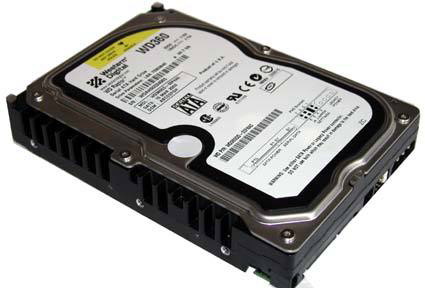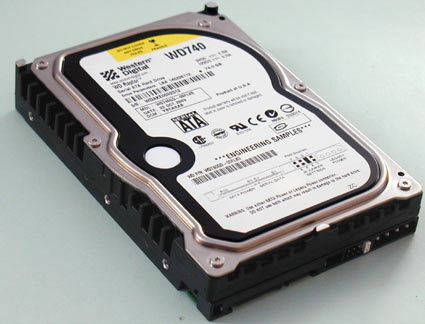VelociRaptor Returns: 6Gb/s, 600GB, And 10,000 RPM
History Of The Raptor
The first Raptor was the WD360. This coincided with Serial ATA's introduction, making the Raptor special in two ways. Not only was it the first desktop hard drive with a 10,000 RPM spindle speed, but it was also one of the first SATA drives. Interfaces were still limited to SATA 1.5Gb/s (or 150 MB/s) at that time, but the interface's simplicity and performance pushed it closer to competing with much more expensive enterprise storage. However, the first Raptor had a disadvantage compared to most enterprise drives: it didn't support command queuing. The WD360GD offered an 8MB cache memory.
WD360 Quick Facts: 8.3 ms average read access time, over 60 MB/s throughput.
The next Raptor (WD740GD) basically updated the initial product, doubling capacity to 74GB. It was faster than the initial drive and was the first drive to support tagged command queuing (TCQ). This allowed incoming commands to be lined up and reordered for most efficient execution. However, compatible SATA controllers were required to enable this.
WD took another two years to revise the Raptor line, doubling the cache capacity from 8MB to 16MB. The enhanced model was again available at 36GB and 74GB (WD360ADFD and WD740ADFD) but this time WD managed to cram 74GB onto a single platter. The modernized version also utilized fluid dynamic bearings, rather than conventional ball bearings, making the new drive more power efficient and noticeably quieter. At the same time, TCQ was dropped in favor of native command queuing (NCQ), although the feature was poorly implemented. We never reviewed the ADFD series, since the next Raptor generation arrived shortly thereafter.
WD740 Quick Facts: 7.8 ms average read access time, over 70 MB/s throughput.
WD renamed named its third-generation drive the Raptor-X and increased capacities to 150GB. The clear cover on one variant (the WD1500AHFD) sought to make this drive even more attractive to enthusiasts, while the regular version lacked the sexy "moon roof." Looks aside, the technical data and benchmark results spoke for themselves. WD integraed NCQ, a 16MB cache, and SATA 1.5Gb/s interface.
WD1500 Quick Facts: 8.0 ms average read access time, over 87 MB/s throughput.
Get Tom's Hardware's best news and in-depth reviews, straight to your inbox.
Finally, the VelociRaptor at 150GB and 300GB arrived in 2008, once again doubling capacity. This marked the first time for a Raptor to inhabit a 2.5” form factor, making it attractive for backplane applications. WD stayed with 16MB cache, 10K RPM, and NCQ, but performance increased significantly. Three models were available: the WD3000BLFS as a 2.5” bare drive, the WD3000HLFS better suited for backplanes (including a 3.5” mount), and the WD3000GLFS with a 3.5” desktop frame that doubled as a heatsink.
WD3000 Quick Facts: 7.8 ms average read access time, over 124 MB/s throughput.
Current page: History Of The Raptor
Prev Page VR200M Follows Up On VR150M Next Page The Newcomer: WD6000HLHX (V200M Series)


